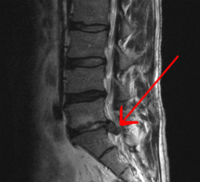
Photo from wikipedia
Anti-resorptive drugs treat bone loss by blocking osteoclast activity through a variety of mechanisms of action. Once significant bone loss has occurred, the ability to restore biomechanical function may differ… Click to show full abstract
Anti-resorptive drugs treat bone loss by blocking osteoclast activity through a variety of mechanisms of action. Once significant bone loss has occurred, the ability to restore biomechanical function may differ based on the drug chosen. To assess this question, bisphosphonate (alendronate, ALN) and cathepsin K inhibitor (MK-0674, CatKi) were employed in treatment mode to compare the relative changes to cancellous bone microstructure and mechanical properties in ovariectomized (OVX) cynomolgus monkeys. Lumbar vertebrae (LV) bone mineral density (BMD) values taken two years post-surgery prior to drug treatment show a 10–15% decrease (p < 0.05) for all OVX animals. OVX animals were then treated with vehicle (VEH), ALN (0.03 mg/kg weekly), or CatKi MK-0674 (0.6 or 2.5 mg/kg daily, CatKi-L and H respectively) for two years and compared to a control Sham surgery group. Ex-vivo microcomputed tomography (μCT) of LV2 and compression testing of LV4–6 were used to measure cancellous bone microstructure and changes in bone mechanics, respectively. After two years of treatment, ALN-treated animals showed no significant difference in μCT or biomechanical parameters when compared to Veh. However, treatment with CatKi-H resulted in a 30% increase in yield and peak loads, and apparent peak and yield stress as compared to Veh (p < 0.05) and gave average mechanical values greater than the Sham sample. Treatment with CatKi-L exhibited a similar trend of increase to CatKi-H (p < 0.08). Intriguingly, these changes were realized despite no significant differences in mean values of trabecular bone morphologic parameters. Together these data suggest matrix-level changes in bone composition that are unique to the CatK inhibition mechanism, resulting in the preservation of bone compressive load with treatment.
Journal Title: Bone Reports
Year Published: 2018
Link to full text (if available)
Share on Social Media: Sign Up to like & get
recommendations!